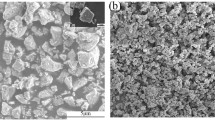Abstract
For very fine, acicular particles of α–Fe prepared for audio/video magnetic recording media, the relationship between their chemical property and surface flatness of the tape material made from the particles was investigated experimentally. It was found that adsorption capacity of acidic resin on the particle surface can be a very good index to predict the flatness of the magnetic tape. Because this index depends strongly on the acidic and basic properties of the particle surface, the tape performance can be well controlled by chemically designing the particle surface of α–Fe.
Similar content being viewed by others
References
Kz. Ohshima, J. Mater. Sci. 31, 519 (1996).
Examples of production methods for our metal pigments are disclosed in the following patents: Brit. Pat. No. 2,068,923 and 2,072,639; US Ser. No. 230,024 and 422,351; USP No. 4,469,507.
K. Tagawa, M. Matsunaga, Kz. Ohshima, M. Hiramatsu, T. Ishibashi, and J. Mikami, IEEE Trans. Magn. MAG-22, 729 (1986).
It is confirmed that the small amounts of S or Na, which are typical chemical impurities remaining in the pigment unavoidably, do not result in the increase of the acidic or basic sites. It seems that the existence of Si and/or Al components used in the chemical modification on the goethite particles is the dominant cause of generation of the acidic/basic sites: C. C. Thomas, Ind. Eng. Chem. 41, 2564 (1946); K. Tanabe, Solid Acids and Bases (Kodansha, Tokyo, Japan, 1970).
K. Tanabe, I. Matsuzaki, Y. Fukuda, T. Kobayashi, K. Kubo, and K. Tanabe, Shokubai (means “Catalyst”) 11, 211 (1969) (written in Japanese).
Its most popular type is known as “VAGH” made by UCC of U. S. A.
An alkylation of phenol by alcohols is one of the most typical catalytic reactions belonging to the application of this phenomenon.
The “simple mathematical model” was developed as follows: First, we prepared carefully nine samples of the metal pigments with “wide” range of [SSA (m2/gr), σs (emu/gr), A (μeq/m2), B (μeq/m2)]: {56.1, 121, 5.28, 5.72}, {48.8, 127, 4.36, 2.84}, {45.5, 125, 4.86, 1.31}, {54.6, 123, 3.73, 1.93}, {47.1, 124, 3.59, 2.25}, {55.1, 121, 4.46, 5.22}, {59.7, 121, 3.40, 1.52}, {54.5, 126, 3.24, 1.47}, and {53.7, 129, 2.63, 1.19}. The estimated values of RA for these samples were 46.1, 20.8, 14.6, 29.6, 20.4, 45.4, 37.6, 15.8, and 29.7 mgr/gr, respectively. Next, to this sample series, we applied the regression analysis by assuming RA = Co + ΣCi*Pi, where Pi’s denote “independent” variables, SSA, σs, A, and B for i = 1, 2, 3, and 4, respectively, and Ci’s are the corresponding fitting parameters, whereas Co is an adjustable constant. We obtained Co of 46. 2 and Ci’s for i = 1 to 4 of + 1.19, 20.676, 21.97, and 14.39 with the correlation coefficient of 92.6%, when the above-mentioned units are used. This resultant formula means that RA increases when SSA either B increases, and/or ss either A decreases.
RA can be estimated as a function of SSA, σs, A, and B: RA = RA (SSA, ss, A, B). Then, to predict the “experimental” value of RA with the specific values of SSA and σs as a function of A and B from the original experimental values of RA, we used Taylor’s expansion method. For example, for SSA and σs of 55 m2/gr and 125 emu/gr, respectively, RA (55, 125, A, B) = RA (SSA, σs, A, B) − C1*(SSA-55) − C2*(σs-125), because δRA (Pi’s)/δPi = Ci for i = 1 to 4. Note the “negative” sign for shifting the original experimental values to the specific state. For the present sample series, RA (55, 125, A, B) were 42.1, 29.5, 25.9, 28.7, 29.1, 42.6, 29.3, 17.1, and 34.0 mgr/gr, respectively. Next, we estimated RA (55, 125, 4, B) or RA (55, 125, A, 5) as a function of B or A by the “shifting” formula RA (55, 125, A, B) − C3*(A-4) or RA (55, 125, A, B − C4*(B-5). The results were 44.6, 30.3, 27.6, 28.2, 28.3, 43.5, 28.1, 15.6, and 31.3 mgr/gr for RA (55, 125, 4, B) or 38.9, 39.0, 42.1, 42.2, 41.2, 41.6, 44.6, 32.6, and 50.7 mgr/gr for RA (55, 125, A, 5) respectively. See Fig. 2 of the text.
Author information
Authors and Affiliations
Rights and permissions
About this article
Cite this article
Ohshima, K. On the reactivity of organic solvents on the particle surface of metal pigment. Journal of Materials Research 13, 711–716 (1998). https://doi.org/10.1557/JMR.1998.0089
Received:
Accepted:
Published:
Issue Date:
DOI: https://doi.org/10.1557/JMR.1998.0089




